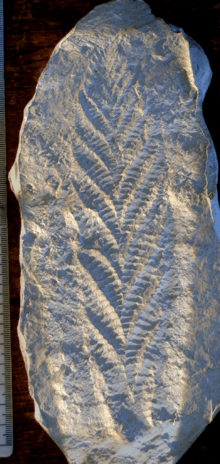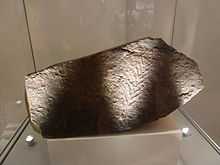Charnia
| Charnia Temporal range: Ediacaran, 579–555Ma | |
|---|---|
 | |
| A cast of the holotype of Charnia masoni. Metric scale. | |
| Scientific classification | |
| Phylum: | Petalonamae |
| Genus: | Charnia Ford, 1958 |
| Species: | C. masoni Ford, 1958 |
| Synonyms | |
| |
Charnia is the genus name given to a frond-like Ediacaran lifeform with segmented, leaf-like ridges branching alternately to the right and left from a zig-zag medial suture (thus exhibiting glide reflection, or opposite isometry). The genus Charnia was named after Charnwood Forest in Leicestershire, England, where the first fossilised specimen was found.
The living organism was a type of fractal life form that grew on the sea floor and is believed to have fed on nutrients in the water. Despite Charnia's fern-like appearance, it is not a plant or alga because the nature of the fossilbeds where specimens have been found demonstrate that it originally lived in deep water, well below the photic zone where photosynthesis can occur.
Diversity
Several Charnia species were described but only the type species C. masoni is considered valid. Some specimens of C. masoni were described as members of genus Rangea or a separate genus Glaessnerina:
- Rangea grandis Glaessner et Wade, 1966[1] = Glaessnerina grandis[2]
- Rangea sibirica Sokolov, 1972 = Glaessnerina sibirica
Two other described Charnia species have been transferred to two separate genera
- Charnia wardi Narbonne et Gehling, 2003[3] transferred to the genus Trepassia Narbonne et al., 2009[4]
- Charnia antecedens Laflamme et al., 2007[5][6] transferred to the genus Vinlandia Brasier, Antcliffe et Liu, 2012[7]
A number of Ediacaran form taxa are thought to represent Charnia (or Charniodiscus) at varying levels of decay; these include the Ivesheadiomorphs Ivesheadia, Blackbrookia, Pseudovendia and Shepshedia.[8]
Distribution
Charnia masoni was first described from Charnwood Forest in England and subsequently was found in Ediacara Hills in Australia,[1][9] Siberia and White Sea area in Russia[10][11] and Precambrian deposites in Newfoundland, Canada.
Discovery

Charnia masoni[12] was brought to the attention of scientists by Roger Mason, a schoolboy who later became a professor of metamorphic petrology, in 1957 in what is now a protected fossil site in Central England. It was named by Trevor Ford, a local geologist. Tina Negus, a 15-year-old schoolgirl at the time, had seen this fossil a year previously[13] but her geography schoolteacher discounted the possibility of Precambrian fossils.[14] The holotype of this species now resides, along with a cast of its sister taxon Charniodiscus, in New Walk Museum & Art Gallery, Leicester.
Significance
Charnia is a highly significant fossil for several reasons. Firstly, it is the first fossil that was ever described that came from undoubted Precambrian rocks. Until this point the Precambrian was thought to be completely devoid of fossils and consequently possibly of macroscopic life. Despite similar fossils being unearthed in the 1930s (in Namibia) and the 1940s (in Australia) these forms were assumed to be of Cambrian age and so were considered unremarkable at the time. Secondly, Charnia has become an enduring image of Precambrian animals. Originally interpreted as an alga (Ford), it was spectacularly recast as a sea pen (a sister group to the modern soft corals) from 1966 onwards (Glaessner). With this image of Precambrian sea pens in mind, the gates were open for the recognition of many other of the major animal groups in the Precambrian. However, this sea pen interpretation has recently been discredited,[15] [16] and the current "state of the art" is something of a "statement of ignorance".[17]
An increasingly popular theory has arisen since the mid-1980s, following the work of Prof Adolf Seilacher who suggested that Charnia belongs to an extinct group of unknown grade that was confined to the Ediacaran Period. This theory suggests that almost all the forms that have been postulated to be members of many and various modern animal groups are actually more closely related to each other than anything else. This new group was termed the Vendobionta,[18] a clade whose position in the tree of life is unclear, perhaps united by its construction via unipolar iterations of one cell family.
Ecology
Little is known about the ecology of Charnia. It was benthic and sessile, anchored to the sea floor. According to one currently popular hypothesis, it probably lived in deep waters, below the wave base (perhaps a great deal below the wave base); this means it could not have photosynthesised. Furthermore, it has no obvious feeding apparatus (mouth, gut, etc.) so its ecology remains somewhat enigmatic. Some have speculated that it survived either by filter feeding or directly absorbing nutrients, and this is currently the focus of considerable research.[19]
The growth and development of the Ediacara biota is also a subject of continued research, and this has discredited the sea pen hypothesis. In contrast to sea pens, which grow by basal insertion, Charnia grew by the apical insertion of new buds.[17]
See also
References
- ↑ 1.0 1.1 Glaessner, M.F.; Wade, M. (1966). "The late Precambrian fossils from Ediacara, South Australia" (PDF). Palaeontology 9 (4): 599.
- ↑ Germs, G. J. B. (1973). "A reinterpretation of Rangea schneiderhoehni and the discovery of a related new fossil from the Nama Group, South West Africa". Lethaia 6 (1): 1–10. doi:10.1111/j.1502-3931.1973.tb00870.x.
- ↑ Narbonne, G.M.; Gehling, J.G., (2003). "Life after Snowball: the oldest complex Ediacaran fossils" (PDF). Geology 31: 27–30. Bibcode:2003Geo....31...27N. doi:10.1130/0091-7613(2003)031<0027:LASTOC>2.0.CO;2.
- ↑ Narbonne, G.M.; Laflamme, M., Greentree, C. and Trusler, P. (2009). "Reconstructing a lost world: Ediacaran rangeomorphs from Spaniard’s Bay, Newfoundland". Journal of Paleontology 83 (4): 503–523. doi:10.1666/08-072R1.1.
- ↑ M. Laflamme; G. M. Narbonne1, C. Greentree & M. M. Anderson (2007). "Morphology and taphonomy of an Ediacaran frond: Charnia from the Avalon Peninsula of Newfoundland". Geological Society, London, Special Publications 286 (1): 237–257. Bibcode:2007GSLSP.286..237L. doi:10.1144/SP286.17.
- ↑ Hofmann, H. J.; O'Brien, S. J.; King, A. F. (2008). "Ediacaran Biota on Bonavista Peninsula, Newfoundland, Canada". Journal of Paleontology 82 (1): 1–36. doi:10.1666/06-087.1.
- ↑ Brasier, M.D.; Antcliffe, J.B.; Liu, A.G. (2012). "The architecture of Ediacaran Fronds". Palaeontology 55 (5): 503–523. doi:10.1111/j.1475-4983.2012.01164.x.
- ↑ Liu, A. G.; McIlroy, D.; Antcliffe, J. B.; Brasier, M. D. (2010). "Effaced preservation in the Ediacara biota and its implications for the early macrofossil record". Palaeontology 54 (3): 607–630. doi:10.1111/j.1475-4983.2010.01024.x.
- ↑ Nedin C.; Jenkins R.J.F. (1998). "First occurrence of the Ediacaran fossil Charnia from the southern hemisphere". Alcheringa 22 (3/4): 315–316. doi:10.1080/03115519808619329.
- ↑ Grazhdankin, Dima (2004). "Patterns of distribution in the Ediacaran biotas: facies versus biogeography and evolution" (PDF). Palæobiology 30 (2): 203–221,. doi:10.1666/0094-8373(2004)030<0203:PODITE>2.0.CO;2.
- ↑ Grazhdankin, D. V.; Balthasar, U.; Nagovitsin, K. E.; Kochnev, B. B. (2008). "Carbonate-hosted Avalon-type fossils in arctic Siberia". Geology 36 (10): 803–806. doi:10.1130/G24946A.1.
- ↑ Ford, T.D. (1958). "Precambrian fossils from Charnwood Forest". Yorkshire Geological Society Proceedings 31 (3): 211–217. doi:10.1144/pygs.31.3.211.
- ↑ Ford, Trevor. "The discovery of Charnia".
- ↑ Negus, Tina. "An account of the discovery of Charnia".
- ↑ Antcliffe, J.B.; Brasier, M.D. (2007). "Charnia and sea pens are poles apart". Journal of Geological Society 164 (1): 49. doi:10.1144/0016-76492006-080.
- ↑ Gary C. Williams. "Aspects of the Evolutionary Biology of Pennatulacean Octocorals".
- ↑ 17.0 17.1 Antcliffe, J.B.; Brasier, M.D. (2008). "Charnia at 50: Developmental Models for Ediacaran Fronds". Palaeontology 51 (1): 11–26. doi:10.1111/j.1475-4983.2007.00738.x.
- ↑ SEILACHER, A. 1984. Late Precambrian and Early Cambrian Metazoa: preservational or real extinctions? 159–168. In HOLLAND, H. D., TRENDAL, A. F. and BERNHARD, S. (eds). Patterns of change in Earth evolution. Springer Verlag, New York, NY, 450 pp.
- ↑ Narbonne
External links
For pictures of Charnia, see:
An article on the discovery of Charnia masoni: